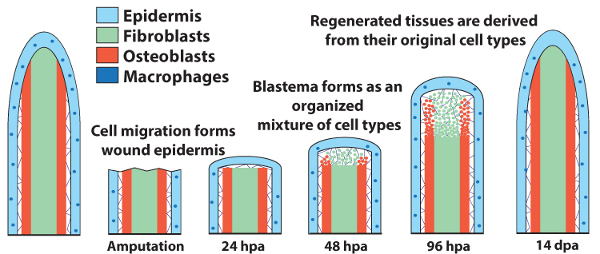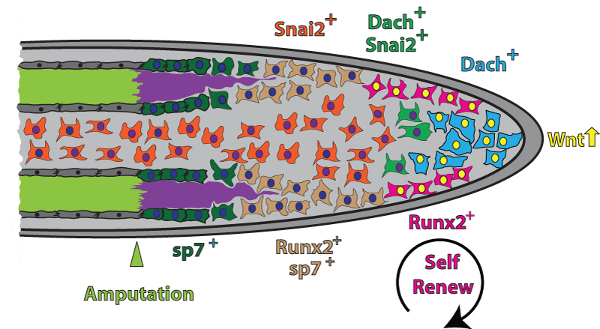Home | About | Faculty | Calendar | Facilities | Graduate program | Contact | Apply
This page is optimized for viewing with javascript.
Scott Stewart

Research Assistant Professor, Biology
Associate Member, IMB
Ph.D., Biological Chemistry, University of Michigan
B.S., Biochemistry, University of Washington
Email
Office: 269A Klamath Hall
Office Phone: 541-346-9180
Loading profile for Scott Stewart
Research Interests
Our long-term goals are to understand the molecular mechanisms that enable zebrafish to regenerate tissues and organs after severe damage, thereby gaining knowledge to rationally design new therapeutics to treat bone maladies. Bone disease and fractures are among the most common, debilitating, and costly human health concerns. While human bone can imperfectly repair, we cannot regenerate lost or severely fractured bones and our capacity for bone repair greatly diminishes with age and disease, such as diabetes. In contrast, throughout their life zebrafish completely regenerate damaged or lost bones after caudal fin amputation, providing an example of innate, perfect bone regeneration that could be recapitulated as a therapeutic strategy. Adult fins comprise multiple cell types, including bone-producing osteoblasts, fibroblasts, endothelial cells, neurons, and epidermal cells (Fig. 1). Following amputation, regeneration of the lost tissue is driven by lineage-restricted progenitors generated by dedifferentiation of mature cells near the injury site. Each of these cell types, and their derived tissues, then regenerate in concert after amputation resulting in a new fin. Though significant progress in the field has been made over the last decade, we still lack answers to the oldest, most basic and pressing questions: A) what triggers regeneration, B) how does the fin “know” when to stop regenerating, and C) why don’t humans regenerate appendages like zebrafish?
Fig. 1. Zebrafish fin regeneration. After fin amputation, epidermal cells migrate to seal the wound. At 24 hours post amputation (hpa), cells near the site of damage dedifferentiate to lineage-restricted progenitors, and by 48 hpa, these cells populate the tissue distal to the amputation site forming the blastema. During regenerative outgrowth (4- 14 days), a balance of cell proliferation, progenitor maintenance, and redifferentiation results in regeneration of the lost tissue.

Fig. 2. Wnt produced by the RPN orchestrates bone regeneration. Following fin amputation, mature osteoblasts dedifferentiate resulting in the generation of Runx2+ pObs (in pink) that are maintained in a self-renewing mesenchymal state by Wnt signals produced by Dach+ RPN cells (green). BMP2b induces differentiation of proximal Runx2+ cells to Runx2+/sp7+ cells (orange), and finally mature sp7+ cells (blue). Dkk1b produced by differentiating osteoblasts in response to BMP serves as negative feedback to further inhibit Wnt.
Recent publications
(pulled from pubmed)
Recent publications
(pulled from pubmed)
Sequential and opposing activities of Wnt and BMP coordinate zebrafish bone regeneration.
Stewart S, Gomez AW, Armstrong BE, Henner A, Stankunas K
Cell Rep 2014 Feb 13;6(3):482-98
Stewart S, Gomez AW, Armstrong BE, Henner A, Stankunas K
Cell Rep 2014 Feb 13;6(3):482-98
Spatial and temporal control of transgene expression in zebrafish.
Akerberg AA, Stewart S, Stankunas K
PLoS One 2014;9(3):e92217
Akerberg AA, Stewart S, Stankunas K
PLoS One 2014;9(3):e92217
Limited dedifferentiation provides replacement tissue during zebrafish fin regeneration.
Stewart S, Stankunas K
Dev Biol 2012 May 15;365(2):339-49
Stewart S, Stankunas K
Dev Biol 2012 May 15;365(2):339-49
A histone demethylase is necessary for regeneration in zebrafish.
Stewart S, Tsun ZY, Izpisua Belmonte JC
Proc Natl Acad Sci U S A 2009 Nov 24;106(47):19889-94
Stewart S, Tsun ZY, Izpisua Belmonte JC
Proc Natl Acad Sci U S A 2009 Nov 24;106(47):19889-94
Bioelectricity and epimorphic regeneration.
Stewart S, Rojas-Muñoz A, Izpisúa Belmonte JC
Bioessays 2007 Nov;29(11):1133-7
Stewart S, Rojas-Muñoz A, Izpisúa Belmonte JC
Bioessays 2007 Nov;29(11):1133-7